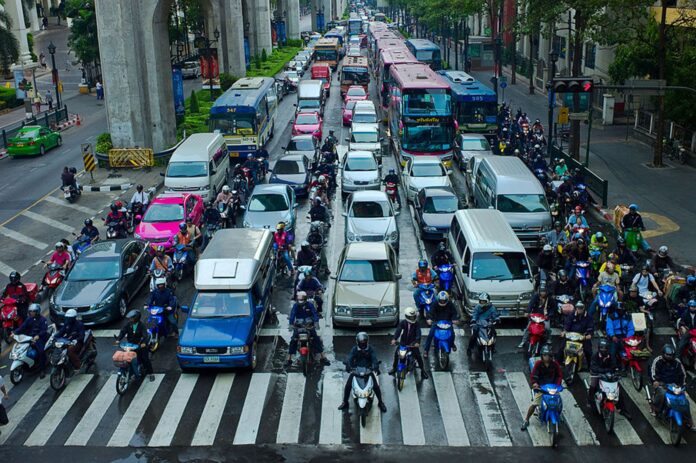Many motorcyclists remain uncertain about the legality of lane splitting in different states. Recent changes in laws nationwide have added to this uncertainty.
California led the way by making lane splitting legal in 2016, though riders there could always practice it. Other states like Arizona, Montana, and Utah now allow lane filtering. Minnesota and Colorado will substantially expand these rights when they permit lane filtering in 2025. The safety data supports this trend. Riders who split lanes face fewer injuries than those who don’t, and rear-end accidents drop from 4.6% to 2.6%.
The rules about moving between lanes vary by state. Lane splitting means riding between moving traffic, while lane filtering refers to moving past stopped or slow vehicles. These terms might sound similar, but each state defines them differently. Let’s examine where you can legally move between lanes in 2025 and what rules apply.
California
California leads the way in legal lane splitting across the United States. Other states have just started allowing lane filtering. The Golden State has always let motorcyclists ride between traffic lanes. Let me show you how California manages this practice and what riders should know.
California lane splitting laws in 2025
The Golden State made history by legalizing lane splitting through Assembly Bill 51 in 2016. This law added Section 21658.1 to the California Vehicle Code. It defines lane splitting as “driving a motorcycle, as defined in Section 400, that has two wheels in contact with the ground, between rows of stopped or moving vehicles in the same lane, including on both divided and undivided streets, roads, or highways”.
California’s rules are different from other states because riders can do full lane splitting instead of just lane filtering. Motorcyclists can legally move between lanes of moving traffic at highway speeds, not just in slow or stopped traffic.
The California Highway Patrol (CHP) created educational guidelines with help from the Department of Motor Vehicles, Department of Transportation, Office of Traffic Safety, and motorcycle safety organizations. The state’s law doesn’t set exact speed limits for lane splitting. It puts the focus on rider judgment and safety.
A newer study, published by UC Berkeley found that lane-splitting riders were involved in 17% of motorcycle crashes in California. This shows how common the practice is. The research also showed that 80% of California motorcyclists split lanes on freeways sometimes, and 37% did it every time they rode on freeways.
California lane splitting safety guidelines
The California Highway Patrol has detailed safety guidelines for motorcyclists who split lanes. Here’s what riders should do:
- Stay within 10 MPH of surrounding traffic speed, as risks go up with bigger speed differences
- Don’t split lanes when traffic moves at 30 MPH or faster because risks increase with overall speed
- Split between the #1 and #2 lanes (furthest left), as drivers expect motorcyclists there
- Think about everything around you – lane width, vehicle size, and road conditions
- Watch out for other drivers’ possible moves
The UC Berkeley study backed these guidelines with data. Lane-splitting seemed safe in traffic moving at 50 MPH or less when motorcyclists stayed within 15 MPH of surrounding traffic. Lane-splitting riders had fewer head injuries (9% vs. 17%), torso injuries (19% vs. 29%), and fatal injuries (1.2% vs. 3.0%) compared to those who didn’t split lanes.
The CHP supports what they call the “Four R’s” or “Be-Attitudes” of lane splitting:
- Be Reasonable: Keep within 10 MPH of traffic flow and under 39 MPH
- Be Responsible: Own your safety and decisions
- Be Respectful: Share the road both ways
- Be aware of all Roadway and traffic conditions
Some situations make lane splitting too risky. These include toll booths, unpredictable traffic, or spaces between large vehicles like trucks and busses.
California lane splitting enforcement and penalties
Lane splitting might be legal in California, but unsafe riding can still get you a ticket. Police officers can decide if a motorcyclist splits lanes in a “safe and prudent manner”. You might get a ticket even without specific speed limits if you split lanes too aggressively.
Unsafe lane splitting can lead to citations for various violations. These include unsafe passing, following too closely, or reckless driving in bad cases. Fines run about $400 with court fees.
California’s Vehicle Code protects lane-splitting riders. Drivers can’t block or impede motorcyclists who split lanes legally. Opening a car door to stop a lane-splitting motorcyclist breaks CVC 22517. Blocking a motorcyclist in ways that could hurt them violates CVC 22400.
Accidents during lane splitting can get complicated. A California Office of Traffic Safety survey found only 53% of drivers knew about legal lane splitting. About 7% said they tried to stop motorcyclists from doing it. Fault in lane-splitting accidents needs careful review of everything – the rider’s speed, traffic conditions, and what other drivers did.
Riders visiting from states without lane splitting should learn these laws and guidelines. The practice takes time to get used to. Following CHP’s safety tips helps riders enjoy this traffic advantage while staying safe and avoiding tickets.
Arizona
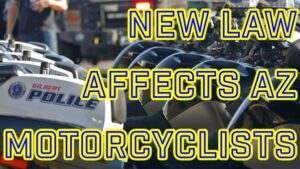
Arizona became the fourth state to allow lane filtering in 2022. This marked a big change for motorcyclists in the Grand Canyon State. Riders have enjoyed new freedoms on Arizona’s roads since September 24, 2022, but the state’s approach differs from California’s more relaxed laws.
Arizona lane filtering rules and limitations
Senate Bill 1273 changed Arizona’s lane filtering law by updating Arizona Revised Statutes Section 28-903. The bill gives motorcyclists specific rights under certain conditions. Motorcycle operators can now pass vehicles that have stopped in the same direction and lane.
The law states that motorcyclists “may operate the motorcycle between lanes of traffic if the movement may be made safely”. In spite of that, riders must follow several key rules:
- Vehicle type restriction: Only two-wheeled motorcycles can filter. Three-wheeled motorcycles, Spyders, Slingshots, and motorcycles with sidecars cannot
- Lane requirements: Riders can filter only on streets that have at least two adjacent traffic lanes going the same way
- Location limitations: No filtering on shoulders, medians, freeways, or interstates
Safety comes first. TEAM Arizona, a motorcycle support group, suggests riders should know their skill level before they try filtering. Out-of-state motorcycle enthusiasts should learn these details to ride safely and legally in Arizona.
Arizona lane filtering speed and traffic conditions
Arizona’s legal lane filtering rules are much stricter than California’s regulations. Riders can only filter when:
- The speed limit is 45 mph or less
- They travel no faster than 15 mph while filtering
- All traffic has stopped
These rules address safety concerns from both supporters and critics. The law aims to reduce rear-end crashes with motorcycles at intersections where riders face the most risk.
Supporters highlight the safety benefits, especially preventing motorcyclists from getting trapped between vehicles. Lane filtering helps in Arizona’s hot climate where stopped motorcycles can overheat. Riders also avoid sitting in extreme temperatures.
Most riders use lane filtering at traffic signals and busy intersections. They can move away more safely from the front when traffic starts moving.
Is lane splitting legal in Arizona?
Lane splitting remains illegal in Arizona despite some confusion among riders and drivers. Every motorcyclist must understand this key difference. One law firm explains it clearly: “No, lane splitting is not legal in Arizona, but lane filtering became legal in Arizona on September 24, 2022”.
The difference depends on traffic conditions and vehicle speeds. California alone allows lane splitting between moving traffic lanes at higher speeds. Arizona only permits filtering when traffic has completely stopped.
People often mix up these terms. KTVK/KPHO reported in April 2024 that some motorcyclists split lanes on highways thinking it was legal. Attorney Joe Brown noted that “the legislature in the State of Arizona did a horrible job educating folks about what is allowed and what is not allowed”.
The Arizona Department of Transportation’s social media shows mixed public opinions about safety. A rider commented that they “only use lane filtering when the vehicles are stopped and there is enough room” and keep “speed at 10mph”.
Arizona’s motorcyclists must know exactly when they can filter legally. This practice helps them navigate busy intersections safely if they follow the state law’s specific conditions.
Utah
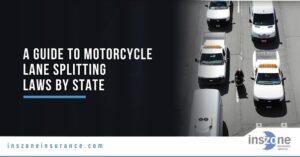
Utah became the second state to legalize motorcycle lane filtering in 2019. The state created a careful framework that’s nowhere near as permissive as California’s lane splitting or Arizona’s recent legislation.
Utah lane filtering legal framework
The state’s lane filtering law took effect in May 2019. It lets motorcyclists move between lanes of stopped traffic under specific conditions. We designed this legislation to boost safety by eliminating rear-end collisions that happen to motorcycles stopped at traffic lights.
People got confused about the terminology right after the law passed. Utah law clearly defines both lane filtering and lane splitting. Utah Code Section 41-6a-102 states that “lane filtering” means “the act of overtaking and passing another vehicle that is stopped in the same direction of travel in the same lane”. The code defines “lane splitting” as “the act of riding a motorcycle between clearly marked lanes for traffic traveling in the same direction of travel while traffic is in motion”.
Riders need to understand this vital difference because lane filtering is legal under specific rules, but lane splitting isn’t allowed. The new HB0190 law passed in 2025 makes this even clearer by banning lane splitting outright. Anyone who breaks this rule faces serious penalties, including losing their motorcycle endorsement.
The rules have changed over time, and recent updates have expanded lane filtering locations. The new HB0311 law from 2025 now allows lane filtering on freeway off-ramps. All the same, you still can’t lane filter on freeway on-ramps or the freeway itself.
Utah lane filtering speed and traffic rules
Utah motorcyclists can only lane filter under these conditions:
- The roadway must have two or more adjacent traffic lanes traveling in the same direction
- The speed limit on the roadway must not exceed 45 mph
- The motorcyclist’s traveling speed must not exceed 15 mph while filtering[121]
- The vehicles being overtaken must be completely stopped[121]
- The maneuver must be executed safely
Utah’s approach is much stricter than California’s rules that allow riding between moving vehicles. The law creates a safe space for motorcyclists in stopped traffic. Once traffic starts moving again, motorcyclists must merge back into a regular lane quickly.
On top of that, the law has strict space rules. You can only lane filter in marked travel lanes – not on shoulders or bike lanes. Riders should be extra careful about having enough space to filter safely.
Utah’s Department of Public Safety makes it clear that lane filtering isn’t required. Their website states: “Lane filtering is a choice and can present unique safety challenges for the inexperienced rider. If riders choose to lane filter, always use extreme caution”. The state’s Ride to Live program warns that new riders shouldn’t try lane filtering.
The new HB0190 law has made enforcement tougher for Utah riders. Breaking motorcycle operation laws, including wrong lane filtering or illegal lane splitting, leads to bigger penalties. Your first offense gets you a 90-day motorcycle endorsement suspension. A second violation extends to 180 days, and a third means you lose your endorsement completely. Peace officers can also impound motorcycles used in violations.
Lane filtering helps cut down traffic at busy intersections, which helped convince Utah lawmakers to legalize it. Many Utah drivers don’t know about this law yet, so riders need to stay alert and drive defensively.
Montana

Montana became the third U.S. state to officially allow limited lane filtering through legislation passed in 2021. The regulations continue to be active as we near 2025. Motorcyclists now enjoy specific freedoms that stand between California’s more open approach and the stricter rules found in Utah and Arizona.
Montana lane filtering legality in 2025
Senate Bill 9 created Montana’s lane filtering law with clear guidelines about when motorcyclists can legally filter between lanes. The law defines lane filtering as “the act of overtaking and passing another vehicle that is stopped or traveling at a speed not in excess of 10 miles an hour in the same direction of travel and in the same lane”.
Montana’s approach strikes a balance between California’s full lane splitting authorization and other states’ restrictive filtering laws. The state allows riders to filter when vehicles move up to 10 mph, while Utah only permits this when traffic completely stops.
Montana’s legal requirements are straightforward with three main conditions:
- The operator must be on a road with lanes wide enough to pass safely
- The motorcycle being overtaken must be either stopped or moving at no more than 10 mph
- Conditions must permit “continued reasonable and prudent operation” of the motorcycle
Montana’s law doesn’t specify road speed limits for lane filtering, unlike Arizona’s regulations. Riders can technically filter on any road with wide enough lanes if they meet other conditions.
The Montana Department of Transportation’s website clearly states, “The Montana Legislature legalized lane filtering in 2021”. This official statement helps both motorcyclists and other drivers understand the practice’s legal status.
Montana lane filtering speed differential rules
Speed restrictions form a crucial part of Montana’s lane filtering law. Motorcyclists can’t go faster than 20 mph when passing stopped or slow-moving vehicles.
This 20 mph limit applies whatever the traffic situation. Riders must stay under this speed even when filtering past completely stopped vehicles.
Montana’s rules about speed differences between motorcycles and other traffic make it unique. Riders can filter when surrounding traffic moves up to 10 mph, while Utah only allows this at complete stops. This gives riders more options in slow traffic.
Genevieve Schmitt, a veteran motorcycle journalist living in Montana, highlights the law’s benefits during road work: “While waiting for construction, we motorcyclists can buzz off to the front of the line for safety… starting from the front gives us a sense of comfort so we can navigate, say, freshly poured gravel at our own pace”.
Montana’s regulations serve more than just traffic flow. The state attracts many motorcycle tourists with its scenic routes. Schmitt points out another benefit: “Riders can move ahead of slower or stopped vehicles and enjoy” areas like Glacier National Park.
Law enforcement officials stress the need for education about these rules. State Senator Russel Tempel, who sponsored the bill and rides motorcycles himself, emphasizes that both riders and drivers need to understand legal lane filtering.
Motorcyclists traveling through Montana should know these specific rules to stay safe and legal.
Hawaii

Image Source: West Hawaii Today
Hawaii stands out from other states in its approach to lane splitting and filtering for motorcyclists. The Aloha State bans both practices today, but it once had a unique shoulder-passing law that let riders find a way through traffic jams.
Hawaii’s unique shoulder-passing law
Hawaii tested a new traffic rule through Act 218 (House Bill 2589) from January 1, 2019, to December 31, 2020. This law gave motorcyclists limited access to road shoulders under specific conditions.
The law, which no longer exists, had these rules:
- The Department of Transportation had complete control to pick which shoulders motorcyclists could use
- Riders could only use shoulders when traffic stopped at intersections or during congestion
- Speed limits on shoulders couldn’t go above 10 mph
- Motorcycles had to go the same way as nearby traffic
- Riders couldn’t make turns from the shoulder
- They needed to merge back when traffic started moving
Hawaii created this test program to tackle its traffic problems, especially in cities. Tim Sakahara from the Department of Transportation pointed out they didn’t have an immediate plan for choosing suitable roads after the law passed. The law came with an end date of December 31, 2020, unless lawmakers decided to extend it.
Hawaii lane filtering vs. lane splitting
Hawaii doesn’t allow lane splitting or filtering today. The law clearly states: “Can we lane split/lane share? No. HRS 291C-153(c)”. This ban continues in 2025, making Hawaii stricter than California, Utah, Arizona, Montana, Colorado, and Minnesota.
Hawaii’s old shoulder-passing law took a different path than states that allow lane filtering between stopped vehicles at intersections. The law let riders use specific road shoulders instead of moving between cars – something most lane filtering states don’t allow.
Here’s the main difference between these practices:
- Lane splitting: Riders move between lanes with moving traffic (only California allows this)
- Lane filtering: Motorcycles pass between stopped or slow vehicles (legal in Utah, Arizona, Montana, Colorado, and Minnesota)
- Shoulder passing: Riders use highway shoulders to pass stopped traffic (Hawaii allowed this from 2019-2020, but not anymore)
Motorcyclists who come from states with legal lane splitting or filtering should know they’ll get tickets for trying these moves in Hawaii. The shoulder-passing rule was the only exception, but that ended years ago.
The Hawaii DOT made it clear in 2018 that riders couldn’t just use any shoulder they wanted, even during the test period. They kept strict rules about which shoulders were okay to use and when.
Hawaii’s perfect year-round riding weather and heavy traffic make it interesting that they’ve chosen stricter rules than many mainland states for motorcycle movement. People visiting from places where lane splitting or filtering is legal need to change their riding style on the islands.
Colorado
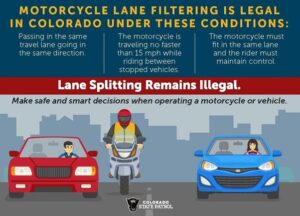
Image Source: Colorado State Patrol
Colorado became the fifth state to allow lane filtering when Governor Jared Polis signed Senate Bill 24-079 into law on April 4, 2024. This new law puts Colorado alongside California, Utah, Montana, and Arizona in permitting motorcycles to move between lanes.
Colorado lane filtering legalization in 2025
The state’s lane filtering law entered its review phase after taking effect on August 7, 2024. The legislation has a sunset provision that automatically expires on September 1, 2027. The Colorado Department of Transportation will study safety data and share results with state legislators before the expiration.
Colorado’s law differs significantly from California’s more relaxed lane splitting rules. The state specifically allows lane filtering – letting riders pass between stopped vehicles. This difference matters because lane splitting between moving traffic lanes remains illegal in Colorado.
Colorado lane filtering rules and restrictions
Motorcyclists can legally filter under these five conditions:
- Traffic in the rider’s lane and adjacent lanes must be completely stopped
- The lane must be wide enough to safely accommodate both the motorcycle and vehicle
- The motorcycle must travel at 15 mph or less while filtering
- The rider must pass on the left of vehicles
- Conditions must permit “prudent operation” of the motorcycle
The law also explicitly bans motorcyclists from:
- Filtering on the right shoulder
- Passing to the right of a vehicle in the farthest right lane
- Filtering in a lane with oncoming traffic
These rules mirror Utah and Arizona’s restrictions but differ from California’s approach to lane sharing.
What riders should know before lane filtering in Colorado
Note that Colorado’s law makes riders responsible for deciding when filtering makes sense. The Colorado State Patrol explains, “The law puts the rider in the position to assess each situation”.
Riders need to understand that filtering remains optional. They must decide if conditions allow safe passage, even when legally allowed.
Many drivers don’t yet understand the new law. The Colorado Department of Transportation created educational materials with stakeholder flyers, audio spots, and social media content to help spread awareness.
The Colorado State Patrol clarified liability issues. Since filtering motorcyclists are the only moving vehicles in stopped traffic, they would typically be at fault in collisions. Riders must be extra careful when checking lane width and watching for unexpected driver movements.
The law received strong support from both parties in Colorado. Safety benefits drove this support, especially the reduced risk of rear-end collisions with motorcycles in stopped traffic.
Minnesota
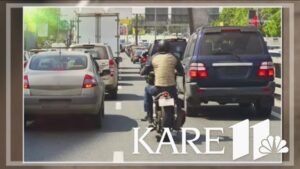
Image Source: YouTube
Minnesota made history as the easternmost state to adopt lane filtering legislation when Governor Tim Walz signed HF 5247 into law on May 24, 2024. This groundbreaking change makes Minnesota the sixth state to allow motorcyclists to move between lanes under specific conditions.
Minnesota lane filtering law effective 2025
The new law will take effect on July 1, 2025, unlike other states that implemented their lane filtering laws right away. This delay gives authorities enough time to educate motorcyclists and drivers about proper procedures.
The bill changes Minnesota Statutes section 169.974 to allow motorcyclists to ride between traffic lanes under two specific conditions:
- The motorcycle must not exceed 25 mph while filtering
- The speed difference between the motorcycle and surrounding traffic must not exceed 15 mph
The legislation sets aside $200,000 from the motorcycle safety fund for a statewide public education campaign. This money will help inform drivers and the public about safe motorcycle passing within the same lane or between parallel lanes.
What makes Minnesota’s law different?
Minnesota’s approach stands out because of its penalties for interfering with motorcyclists. Motor vehicle operators who “intentionally impede or attempt to prevent any operator of a motorcycle from operating a motorcycle as permitted” will face petty misdemeanor charges.
A personal story sparked Minnesota’s law rather than policy discussions. Phil Stalboerger, a motorcyclist who got rear-ended while stopped in traffic in 2022, became the catalyst for this legislation after he shared his experience with lawmakers.
Tips for riding in Minnesota under new law
Safety comes first when using Minnesota’s lane filtering provision:
- Assess each situation individually – Legal filtering doesn’t always mean safe filtering
- Stay visible – Clear signals and proper positioning will help drivers notice you
- Respect the speed limits – The rules are simple: 25 mph maximum speed and 15 mph differential
- Stay informed – Minnesota’s public education campaign will provide more guidance
Motorcyclists and drivers will need time to adapt to these new road dynamics when the law takes effect.
Conclusion
This piece has shown how lane splitting and filtering laws are changing in the United States. California is the only state that allows full lane splitting right now. But there’s good news – states like Utah, Arizona, Montana, Colorado, and Minnesota now permit lane filtering. This shows a real transformation in motorcycle traffic laws. The change comes from new evidence that these practices help keep riders safe by cutting down on rear-end crashes.
Riders who travel between states need to know the differences between these practices. Lane splitting, which means riding between moving traffic, is different from lane filtering where you move between stopped or slow vehicles. Each state has its own rules about speed limits and conditions. The penalties can be tough too – you could face fines or even lose your license.
The safety numbers back up why more states are making it legal. Riders who lane-split have fewer injuries compared to those who don’t: head injuries (9% vs. 17%), torso injuries (19% vs. 29%), and fatal injuries (1.2% vs. 3.0%). In spite of that, riders must use good judgment to decide when it’s safe to filter or split.
People who ride in multiple states must stay up to date with these laws. While six states now let riders move between lanes in some way, most states still say no to these practices. So riders have to change how they ride when they cross state lines to avoid tickets.
More states will likely allow lane filtering as they review the safety benefits and see how it helps reduce traffic jams. For now, my advice is simple – learn what each state requires where you ride and put safety first, whatever the law allows.

